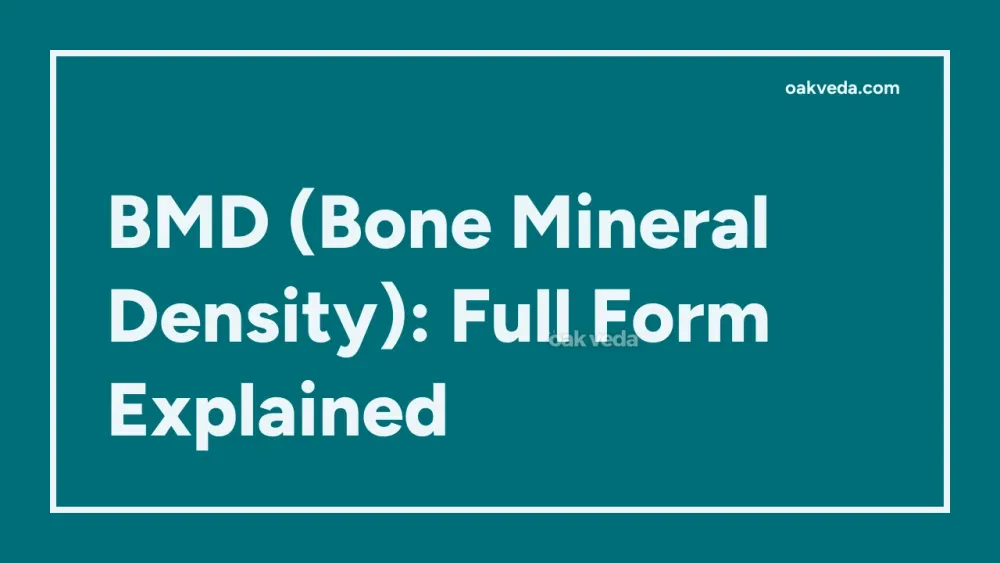
What is the Full Form of BMD?
The full form of BMD is Bone Mineral Density. This acronym is widely used in the medical field, particularly in the areas of orthopedics, endocrinology, and radiology. BMD is a crucial measurement that helps healthcare professionals assess bone strength and overall bone health.
What is Bone Mineral Density?
Bone Mineral Density refers to the amount of mineral content, primarily calcium and phosphorus, present in a specific volume of bone. It is an essential indicator of bone strength and health, providing valuable insights into an individual's risk of fractures and bone-related disorders such as osteoporosis.
Origin and Development of Bone Mineral Density Testing
The concept of measuring bone density dates back to the mid-20th century. However, it wasn't until the 1980s that BMD testing became more widely available and standardized. The development of dual-energy X-ray absorptiometry (DXA or DEXA) in the late 1980s revolutionized BMD measurement, making it more accurate, accessible, and less invasive.
How does Bone Mineral Density Testing Work?
BMD testing is a non-invasive procedure that uses low-dose X-rays to measure the density of minerals in your bones. During the test, patients lie on a table while a scanner passes over their body, focusing on specific areas such as the hip, spine, or forearm. The X-rays are absorbed differently by bones with varying mineral content, allowing the machine to calculate the bone density.
Types of Bone Mineral Density Tests
There are two primary types of BMD tests:
-
Central DXA (Dual-energy X-ray Absorptiometry): This is the most common and accurate method. It measures bone density in the hip, spine, and sometimes the forearm.
-
Peripheral DXA: This type focuses on peripheral bones such as the wrist, finger, or heel. While less comprehensive than central DXA, it can be useful for initial screening.
Functions of Bone Mineral Density Testing
BMD testing serves several important functions:
- Early Detection: It helps identify bone loss before a fracture occurs.
- Diagnosis: BMD tests are crucial in diagnosing osteoporosis and other bone disorders.
- Monitoring: They allow healthcare providers to track the progression of bone loss over time.
- Treatment Evaluation: BMD tests help assess the effectiveness of osteoporosis treatments.
Applications of Bone Mineral Density Testing
BMD testing is applied in various medical scenarios:
- Osteoporosis Screening: Regular BMD tests are recommended for postmenopausal women and older men at risk of osteoporosis.
- Fracture Risk Assessment: BMD results, combined with other factors, help predict the risk of future fractures.
- Medication Monitoring: For patients on bone-strengthening medications, BMD tests track treatment efficacy.
- Secondary Osteoporosis Evaluation: BMD tests can help diagnose bone loss caused by other medical conditions or treatments.
Features of Bone Mineral Density Testing
Key features of BMD testing include:
- Non-invasive: The procedure is painless and doesn't require any injections or incisions.
- Low Radiation: BMD tests use very low doses of radiation, making them safe for most patients.
- Quick and Easy: The test typically takes only 10-30 minutes to complete.
- Widely Available: Most hospitals and many clinics offer BMD testing services.
Benefits of Bone Mineral Density Testing
BMD testing offers numerous benefits:
- Early Intervention: It allows for early detection and treatment of bone loss, potentially preventing fractures.
- Personalized Treatment: BMD results help doctors tailor treatment plans to individual patients.
- Motivation for Lifestyle Changes: Test results can motivate patients to make bone-healthy lifestyle choices.
- Cost-effective: By preventing fractures, BMD testing can reduce long-term healthcare costs.
Limitations or Challenges of Bone Mineral Density Testing
Despite its benefits, BMD testing has some limitations:
- Not a Perfect Predictor: While helpful, BMD alone doesn't predict all fractures.
- Variability: Results can vary slightly between machines or technicians.
- Limited Accessibility: In some areas, access to BMD testing may be limited.
- Interpretation Challenges: Factors like arthritis can complicate result interpretation.
Future Developments in Bone Mineral Density Technology
The field of BMD testing continues to evolve:
- 3D Imaging: Advanced 3D imaging techniques may provide more detailed bone structure information.
- Artificial Intelligence: AI could improve the accuracy of fracture risk predictions based on BMD and other factors.
- Portable Devices: Development of more portable BMD devices could increase accessibility, especially in remote areas.
- Integration with Other Tests: Combining BMD with other bone quality measures may provide a more comprehensive bone health assessment.
FAQs on BMD Full Form
-
Who should get a BMD test? BMD tests are typically recommended for women 65 and older, men 70 and older, and younger adults with risk factors for bone loss.
-
How often should BMD tests be done? The frequency depends on individual risk factors, but generally every 2-5 years for those at risk.
-
Can BMD tests diagnose arthritis? No, BMD tests specifically measure bone density and cannot diagnose arthritis directly.
-
Is BMD testing covered by insurance? Many insurance plans cover BMD testing, especially for individuals at higher risk for osteoporosis.
-
Can I improve my BMD? Yes, through proper nutrition (especially calcium and vitamin D), weight-bearing exercise, and sometimes medication.
Understanding the full form of BMD - Bone Mineral Density - is crucial for anyone concerned about bone health. This valuable diagnostic tool plays a vital role in preventing, diagnosing, and managing bone-related conditions, ultimately contributing to better overall health and quality of life.
You may be interested in:

